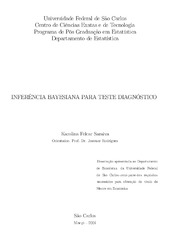Inferência bayesiana para teste disgnóstico.
Resumen
The simpler screening tests applied to detect disease instead of the more elaborated, usually result in the risk of incorrect diagnostic. However, these tests are only useful when the risks of misclassifications are known and considered acceptably low. So, with the purpose of looking for information on the proprieties of screening tests, as well as measuring their error rates, a Bayesian procedure was formulated using a simulation technique (Gibbs Sampling with latent variables) for estimation of the parameters of interest in the absence of a gold standard. Two applications to real data have been explored. The first one refers to the detection of the infection caused by the strongyloides parasite on 162 refugees from Cambodia that arrived in Montreal, Canada, between July 1982 to February 1983, using data from serologic test and stool examination. The second one has the purpose detecting the obesity rates on males and females school pupils through the information supplied by the anthropometric Must and Cole criteria.
